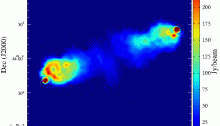Abstract
Context. The LOw Frequency ARray (LOFAR) radio telescope is a giant digital phased array interferometer with multiple antennas distributed in Europe. It provides discrete sets of Fourier components of the sky brightness. Recovering the original brightness distribution with aperture synthesis forms an inverse problem that can be solved by various deconvolution and minimization methods Aims. Recent papers have established a clear link between the discrete nature of radio interferometry measurement and the "compressed sensing" (CS) theory, which supports sparse reconstruction methods to form an image from the measured visibilities. Empowered by proximal theory, CS offers a sound framework for efficient global minimization and sparse data representation using fast algorithms. Combined with instrumental direction-dependent effects (DDE) in the scope of a real instrument, we developed and validated a new method based on this framework Methods. We implemented a sparse reconstruction method in the standard LOFAR imaging tool and compared the photometric and resolution performance of this new imager with that of CLEAN-based methods (CLEAN and MS-CLEAN) with simulated and real LOFAR data Results. We show that i) sparse reconstruction performs as well as CLEAN in recovering the flux of point sources; ii) performs much better on extended objects (the root mean square error is reduced by a factor of up to 10); and iii) provides a solution with an effective angular resolution 2-3 times better than the CLEAN images. Conclusions. Sparse recovery gives a correct photometry on high dynamic and wide-field images and improved realistic structures of extended sources (of simulated and real LOFAR datasets). This sparse reconstruction method is compatible with modern interferometric imagers that handle DDE corrections (A- and W-projections) required for current and future instruments such as LOFAR and SKA.


